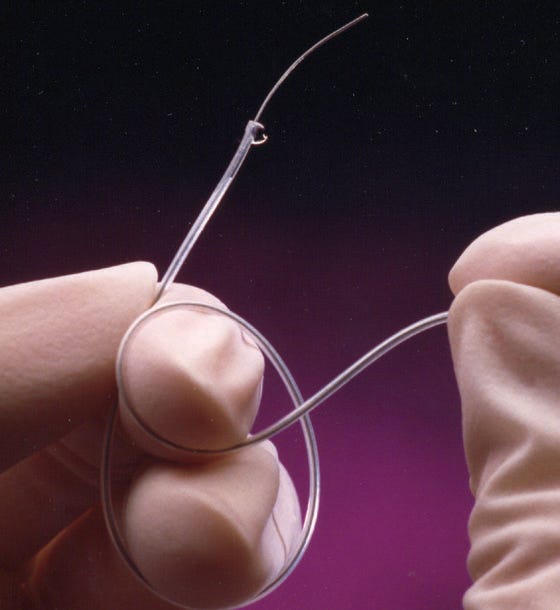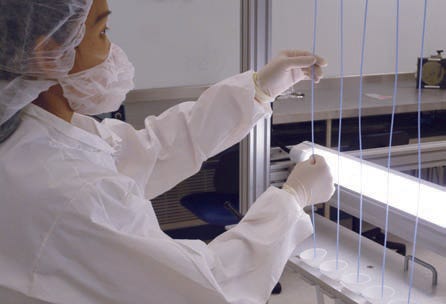Lubricious Coatings Give Minimally Invasive Devices the Slip
Increasingly relied upon to ease friction, lubricious coatings must balance lubricity and durability to meet industry demands
June 28, 2010
|
SurModics employs a proprietary UV-based technology for applying its Harmony lubricious coatings to medical devices. |
Not just a phrase reserved for road signs and an immensely popular 1986 Bon Jovi album, 'slippery when wet' is also the core concept behind many lubricious coatings for medical applications. Because polymers are often inherently hydrophobic, plastic devices such as catheters can experience friction when they come into contact with body tissue. The inclusion of a hydrophilic lubricious coating--terms that are often used interchangeably in the context of coatings--on the surface of such a device, however, renders it slippery when exposed to blood and other body fluids. By reducing friction, lubricious coatings help minimize patient trauma as well as expedite and facilitate device delivery.
To help navigate the tortuous terrain inside the body, the device coating requires a delicate balance of lubricity and durability. "What everyone wants is a coating that is perfectly lubricious--offers no resistance at all--but at the same time can never come off the catheter in any way, shape, or form, and is completely stable and durable to mechanical forces," states Paul Nowatzki, business development manager for medical coatings at Bayer MaterialScience LLC (Pittsburgh, PA).
Although that's a tall order, providers of lubricious coating technologies are striving to achieve such attributes. And it's not just the coating chemistry that counts; with lubricious coatings, the application method is also a major factor in ultimately determining the slipperiness and adhesion properties of the coating.
As Pure as Water
Within the lubricious medical coatings market, most compounds are fairly similar, says William Lee, director of R&D at AST Products Inc. (Billerica, MA). "It's more about the methods that are different," he states. "In general, there are two types of coating solutions, water based and solvent based, and in order to activate the chemical reactions, heat, UV, plasma, corona, etc. are applied."
As an aqueous-based lubricious coating, AST's LubriLast does not include organic solvents. The use of water for coating attachment can offer several advantages over solvent-based methods, including a more environmentally friendly process. In addition, the lack of organic solvents eliminates the opportunity for residual solvents on the device, which can negatively affect performance or regulatory approval, according to Lee.
Instead of relying on solvents, the LubriLast technology centers on a stabilization technique that involves cross-linking and covalently bonding a non-water-swellable supporting polymer network to the device substrate. Blending hydrophilic molecules with an aqueous polymer dispersion yields a long chain of biocompatible hydrophilic polymer. Upon incorporating the polymer chain into the coating, it becomes partially entangled with the supporting polymer network on the surface to create an anchor of sorts, referred to as an interpenetrating polymer network. The remaining exposed areas of the chain can become hydrated and provide the desired lubricity to the device.
|
A catheter is dip coated to apply AST's LubriLast lubricious coating to facilitate smooth and speedy device delivery in the body. |
Surface modification of the device is executed through a relatively straightforward process, Lee states. "We need to first clean the surface because without cleaning, coatings may not adhere well to the surface," he says. "Depending on the substrate, people might just use alcohol to clean the surface or [they] might use plasma to clean the surface." Following the surface-preparation step, the device undergoes either a dip- or brush-coating process, which is determined by the product. The device is then cured in an oven at 60° to 65°C for a period of time ranging from a half hour to an hour.
When applied to such devices as catheters, guidewires, balloons, and urethral stents, LubriLast technology virtually eliminates the coefficient of friction (COF) in an aqueous environment, according to the company. It claims that tests have demonstrated a static COF of 0.009 and a kinetic COF of less than 0.005 on a LubriLast-coated polyethylene substrate. Furthermore, the company states that chemical cross-linking of the supporting polymer network provides durability and strong adhesion that contributes to a coating life span of more than 100 cycles.
Let There Be (UV) Light
Taking a different approach to lubricious coating application is SurModics Inc. (Eden Prairie, MN). "We have a proprietary UV-based technology, but in the last 18 months or so, there is at least one other company that we know of that is touting a UV-based curing process as well," explains Joe Ventura, the company's director of business development for device applications. Ventura adds that SurModics believes that, based on in-house testing and customer feedback, its coating technology is more durable, however.
The company attributes the durable nature of the Harmony advanced lubricity coatings to the underlying chemistry of its patented PhotoLink process. By exposing the device's substrate to UV light, the process induces photochemical covalent coupling of the coating molecules to the substrate surface. "Our hydrophilic coating is tied to a UV-cure chemistry, and what that allows us to do is achieve strong covalent bonds where the coating and the material substrate meet," Ventura says. "We are also able to achieve those same covalent bonds throughout the coating matrix itself." It is these covalent bonds that ensure firm adhesion of the coating to the substrate during device use.
The PhotoLink platform also promotes flexibility for OEMs. Customizable, the platform can be tailored to accommodate specialty designs, thin-wall construction, and varying geometries. Plus, a range of metal and plastic substrates can be coated. Chemistry flexibility also allows for custom formulations to couple lubricity with antimicrobial or other agents for enhanced properties.
Formulation recipes, along with the substrate material and the device's application, factor into determining the lubricity of a specific Harmony coating. However, the company claims that the technology is typically able to achieve up to 95% friction reduction in a given device. "[Lubricious] coatings are used in applications for the heart, the brain, and the body," Ventura comments. "Companies have leveraged our hydrophilic coating as a natural part of the design engineer's toolbox. Our hydrophilic coating is used to ease the friction forces associated with the initial access into the patient as well as to navigate the delivery device more effectively to the final treatment location."
When There's No Cure
Unlike the thermal- and UV-curing coating technologies offered by other companies, the Baymedix CL 100 lubricious coating does not undergo a conventional curing process. Rather than applying a coating solution to a device and then curing it, the Baymedix technology relies instead on the growth of a rapid-curing polymer to functionalize the device surface.
"Our coating technology is relatively different from what's on the market," says Nowatzki of Bayer MaterialScience. "We first activate the surface of the device with a gaseous activation process that puts functionality on the surface. We then use that to graft or grow a polymer from the surface of the device, [which is] done in an aqueous coating solution." This direct-grafting technique yields strong covalent bonds, Notwatzki notes, which are responsible for firm adhesion of the coating to the device. It also features a low COF of less than 0.03 and is less than 5 µm thick.
Among the most significant advantages of Baymedix compared with competing lubricious technologies, according to Nowatzki, is that it facilitates the coating of device lumens. "We have done on a developmental basis the insides of various tube and catheter-type products and demonstrated that we can make those basically as highly lubricious as we and others make the outer surfaces of devices." He states that other lubricious coating technologies either are not capable of performing this feat or can not do so as easily or quickly as is possible with the Baymedix platform.
As a result, this lubricious coating technology could improve a variety of minimally invasive delivery devices. "By having lubricious coatings, you're enabling less-invasive techniques," Nowatzki concludes. "It's about enhancing the function of existing devices and enabling devices that, without a lubricious coating, would be difficult or impossible to use as intended."
You May Also Like



